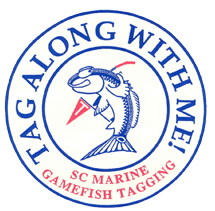Marine - Species
Black Drum (Pogonias cromis)
General Description
Deep-bodied, silvery-gray to dark gray with blackish fins. Young fish have 4 – 5 vertical black bars that disappear with age. Mouth inferior and horizontal, lower jaw with 10 – 13 pairs of barbels in multiple rows. Body scales large and comblike, lateral line extends to hind margin of tail fin.
Average Size
14 inches, 2.2 pounds;
South Carolina State Record: 89 pounds (1978);
maximum age: approx. 60 years
Habitat
Adults: Common over sandy and soft live bottoms in salt and brackish water including: estuaries, coastal rivers, shallow coastal bays, and along beaches. Spatial distribution closely tied to natural and artificial hard structures, including: reefs, rock piles, jetties, docks, pier pilings, and bridges.
Juveniles: Common over muddy bottoms in shallow tidal creeks and salt marsh. Subadults progress to deeper creeks, river mouths, and bays and into nearshore coastal waters.
Reproductive Cycle
- Mature by 4 – 6 years of age; approx. size at maturity: males – 23 inches, females – 25 inches.
- Spawning occurs during spring and early summer in high salinity inlets, estuaries, bays, sounds, and coastal rivers. Adults may form schools for migration to spawning grounds.
- Larvae use tidal currents to enter estuaries where they settle in shallow tidal creeks. Older juveniles leave deeper inshore waters during fall, migrate offshore to overwinter, and return inshore in the spring.
Foraging Habits
- Black drum are bottom feeders and use their sensitive chin barbels to aid in locating food. Heavy pharyngeal teeth are used to crush invertebrates.
- Adults: Feed primarily on mussels, oysters, crabs, shrimp and occasionally small fishes.
- Juveniles: Consume small crabs, amphipods, copepods, shrimp, marine worms, and small fishes. Diet of larger juveniles is similar to adults. Larvae consume primarily zooplankton.
Availability/Vulnerability to Harvest
- Adults tolerate wide salinity ranges; distribution is therefore tied to temperature and availability of hard structures or oyster reef habitat. In South Carolina, black drum are most abundant in nearshore or coastal waters February – July; cold may induce movement to deeper bays, sounds or offshore waters to overwinter.
- No commercial fishery exists for black drum in South Carolina; however, recreational harvest is potentially high since this species occupies nearshore waters during most of the year.
- Conservation concerns: degradation or loss of estuarine nursery habitat; potential for significant recreational harvest; lack of biological and spawning location data for South Carolina black drum.
Literature Cited
Fischer W. 1978. FAO identification sheets for fisheries purposes: western central Atlantic (fishing area 31) volume 1 – 7. Food and Agriculture Organization of the United Nations, Rome.
Goldstein RJ. 2000. Coastal fishing in the Carolinas: from surf, pier, and jetty. John F. Blair Publisher, Winston-Salem, NC. 243 pp.
Jones CM, B Wells. 1998. Age, growth, and mortality of black drum, Pogonias cromis, in the Chesapeake Bay region. Fish Bull 96: 451-461.
Moore CJ. 1996. A field guide to the identification of marine species regulated in South Carolina coastal waters. Office of Fisheries Management, Marine Resources Division, South Carolina Wildlife and Marine Resources Department, Charleston, SC. 105 pp.
Moore CJ, M Barkley. 2005. South Carolina's guide to saltwater fishes. South Carolina Department of Natural Resources, Special Publication. Columbia, SC. 132 pp.
Murphy MD, RG Taylor. 1989. Reproduction and growth of black drum, Pogonias cromis, in northeast Florida. Northeast Gulf Sci 10: 127-137.
Neiland DL, CA Wilson. 1993. Reproductive biology and annual variation of reproductive variables of black drum in the northern Gulf of Mexico. Trans Amer Fish Soc 122: 318-327.
Peters KM, RH McMichael Jr. 1990. Early life history of black drum Pogonias cromis (Pisces: Sciaenidae) in Tampa Bay, FL. Northeast Gulf Sci 11: 39-58.
Silverman MJ. 1979. Biological and fisheries data on black drum Pogonias cromis (Linnaeus). Sandy Hook Laboratory, Northeast Fisheries Center, National Marine Fisheries Service. Highlands, NJ. 35 pp.
Sutter FC, RS Waller, TD McIlwain. 1986. Species profiles: life histories and environmental requirements of coastal fishes and invertebrates (Gulf of Mexico) – black drum. U.S. Fish Wildl Serv Biol Rep 82 (11.51). U.S. Army Corps of Engineers, TR EL-82-4. 10 pp. Accessed: August, 2009.


